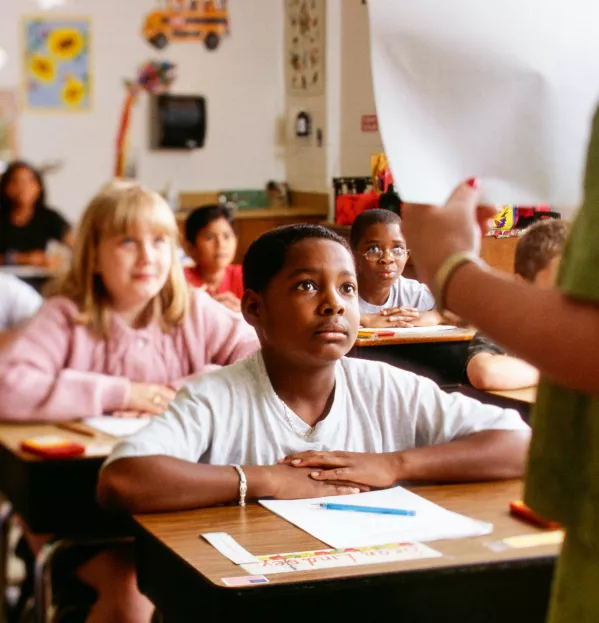- Home
- Teaching & Learning
- General
- What is pedagogy?
What is pedagogy?

People often talk about “pedagogical approaches” to teaching. But what does this actually mean?
What is pedagogy?
Pedagogy is defined simply as the method, and practice, of teaching. It encompasses teaching approaches, teaching theory and feedback and assessment.
When people talk about the pedagogy of teaching, they will be referring to the way teachers deliver the content of the curriculum to a class.
When a teacher plans a lesson, they will consider different ways to deliver the content. That decision will be made based on their own teaching preferences, their experience and the context in which they teach.
How does setting change the pedagogical approach?
Differences in the age of the pupils and the content being delivered can influence the pedagogical practices a teacher will choose to use.
Teachers may use research from many different academic disciplines to inform their decisions, alongside their experience of teaching those age groups. For example, an early years foundation stage teacher may reference cognitive development research alongside their experience of successfully using guided play.
The justifications behind the decisions will become the pedagogical principles, and every teacher will develop their own pedagogical principles over time.
What are the pedagogical approaches?
The different pedagogical approaches could be broken down into four categories: behaviourism; constructivism; social constructivism; and liberationist.
1. Behaviourism
A behaviourist pedagogy uses the theory of behaviourism to inform its approach. A behaviourist pedagogical approach would say learning is teacher centred. It would advocate the use of direct instruction, and lecture-based lessons.
What does a behaviourism pedagogical approach look like in a classroom?
The theory of behaviourism in a classroom setting came from pedagogical research by Thorndike (1911), Pavlov (1927) and Skinner (1957). Behaviourist pedagogy is the theory that the teacher should be the sole authority figure and lead the lesson. Knowledge should be delivered in a curriculum where each subject is taught discretely (as opposed to topic-based learning, for example).
In a lesson using a behaviourist pedagogical approach, you could expect to see a mixture of activities, including lecturing, modelling and demonstration, rote learning and choral repetition. All of these activities are “visible” and structured, as well as being led by the teacher. However, during the course of the lesson, the shift may come where the pupil is the centre of the activity and demonstrates their learning.
Behaviourism is also sometimes described as a “traditional” teaching style.
2. Constructivism
Constructivism is a theory that people learn through experiences and reflection. A constructivist pedagogy puts the child at the centre of the learning, and is sometimes called “invisible pedagogy”. A constructivist approach might incorporate project work and inquiry-based learning, and might adopt a Montessori or Steiner method.
What does a constructivism pedagogical approach look like in a classroom?
Constructivism is based on the pedagogical research of Piaget (1896-1890). Piaget wrote extensively about “schemas”, drawing on the idea that learners come ready to learn, and the teacher must build activities to facilitate their learning. Younger children, so the thinking goes, work concepts through physically, whereas older children are capable of tackling symbolic and abstract ideas.

A lesson might include individualisation, a slower pace, hidden outcomes, the Mantle of the Expert and less teacher talk. Some adopters of this pedagogy would also place emphasis on being outdoors and engaging with nature.
Constructivism is also sometimes described as a “progressive” teaching style.
3. Social constructivism
A social constructivism pedagogy could be considered a blend of two priorities: teacher-guided and pupil-centred learning. Cognitive psychologist, Lev Vygotsky developed social constructivism, building on Piaget’s work, while arguing against Piaget’s belief that learning can only happen in the social context of a pupil being guided by someone more knowledgeable. Vygotsky believed learning was more of a collaborative process between pupil and teacher.
What would a social constructivism approach look like in a lesson?
The teacher might use group work elements but would engineer smaller group sizes and limit the choice of topics. The teacher might also use teacher modelling, questioning and a mixture of individual, pair and whole-class instruction.
4. Liberationism
Liberationism is a critical pedagogy developed by Brazilian educator Paulo Freire. Freire developed a teaching approach that enabled him to teach illiterate adults to read in just 45 days. He focused on removing two key barriers to learning: poverty and hunger.
In his book Pedagogy of the Oppressed, Freire wrote about the dehumanisation of pupils in schools, and argued for cooperation and unity.
A liberationist approach places pupil voice at its centre and approaches the classroom as a democracy. Value is placed on the teacher being positioned as a learner, and the class discovering subjects together.
What would a social constructivist approach look like in a lesson?
The teacher might use examples of literature that contain non-standard constructions, such as hip-hop or graffiti. Pupils might take on the role of the teacher and decide upon the topic of the lesson. The teacher would provide space and opportunity for the pupils to showcase their learning; this would perhaps take the form of a performance, speech or dance.
What is the history of pedagogy?
The origins of teaching in the Western world are often traced back to Ancient Greece, when, in the 5th Century BC, Socrates became known as the keystone of what we now consider to be modern education.
The role of the teacher developed from there, with the first organised schools appearing in England as early as AD597. It is believed that the first school in England was King’s School in Canterbury, Kent. Like many of the first schools, King’s School had links to the church. Today, it operates as an independent school.
The content of the curriculum in these early schools was split into two sections: “trivium” and “quadrivium”. Trivium was made up of grammar, rhetoric and logic. Quadrivium included arithmetic, astronomy, geometry and music.
Lessons took the form of a lecture, with a teacher leading the pupils while they read and offering explanations for the texts. The pupils were given questions. They argued through the answers among themselves, then with pupils who were more senior to them, before they finally engaged with the masters who had taught them.
How did the first schools approach pedagogy?
By 1780, the church, and other charitable groups in England were responding to the need to educate the illiterate poor. Over the next few decades, ragged schools, parish schools and church schools became established to educate children whose families didn’t have the money to send them to the existing fee-charging schools.
Ragged schools started with large classes of 30-40 pupils, who were taught to read from the Bible using oral approaches. Church schools tended to use what was known as the Lancaster method, which involved the pupil who was considered the most able teaching what he had learned to his fellow pupils, each of whom then passed it on, with the process continuing until everyone had been taught.
It wasn’t until the latter half of the 19th century that the first teacher training colleges were established in England. Universities first became involved in teacher training in 1890, before the 1902 Education Act enabled the new local education authorities to set up their own training colleges with links to schools.
I want to read more about pedagogy, what should I read?
For a book, try Urban Myths About Learning and Education by Pedro De Bruyckere, Paul A. Kirschner and Casper D. Hulshof, Visible Learning and the Science of How We Learn by John Hattie and Gregory Yates, or Cleverlands: The Secrets Behind the Success of the World’s Education Superpowers by Lucy Crehan.
For a blog, try Engagement: Just because they’re busy, doesn’t mean they’re learning anything by Carl Hendrick.
For a research paper, try The Effectiveness of Direct Instruction Curricula: A Meta-Analysis of a Half Century of Research (2018).
Get the latest news on teaching research and pedagogy
topics in this article



